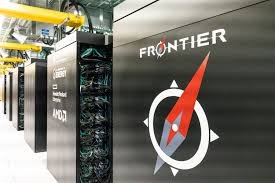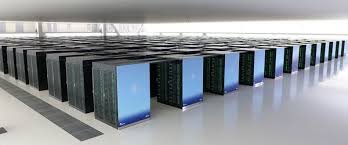Supercomputers: Pushing the Boundaries of Computational Power
Supercomputers:
Mainframes stand for such high-level computing capacity as applies to solve the problems beyond the scope and real processing capability of usual computers. These very sophisticated devices are fundamental to research right from physical science to engineering, climatology, and of course, artificial intelligence (AI). Supercomputers enable fast analysis of extensive data that contributes towards the faster development of solutions to complex issues found globally.
What is a Supercomputer?

Supercomputer is the sophisticated machine containing the highest technological advancement where the FLOPS of identity excluding points portrays the competence of many quadtrillions in one second. These machines are built from tens of thousands and occasionally millions of related microprocessors which are all in operation in parallel.
These machines are comprised of thousands sometimes millions of processors that are all networked and they’re able to perform highly complex calculations simultaneously.
Super computers are intended to provide solution for applications requiring large amount of storage like climate modeling, control of nuclear power and determination of molecular structure. for instance, weather modeling relies on supercomputer to model climate all over the world to predict natural disasters, monitor climate change directly and plan for agriculture production.
Architecture of Supercomputers:

Processing Units: Now let me explain as a supercomputer has many CPU and GPU systems, therefore, many computers work together in parallel. These processors are organized in to nodes; these nodes act as individual process units.
Interconnects: A supercomputer consists of nodes which are interconnected with high speed so that data can be transferred quickly from one processor to another. Some common interconnect technologies are InfiniBand and others are proprietary systems where they let no latency and offer high data rate.
Memory and Storage: The major reason is that supercomputer involves a large number of calculations that involve switching of large amount of data which must be stored in the computer. To solve computations, data must be accessed instantly which makes maximum use of high-performance memory [RAM], SSD or Specific Storage Systems.
Metrics of Supercomputers:
Parallelism: The inherent capability of the supercomputer by the functions that it is able the perform at one time is of great importance. Modern systems are capable of processing millions of tasks at once and therefore are perfectly suitable for tasks that are based on large scale simulation and data processing.
Power Consumption: Supercomputers are a form of computer that draws high power in order to perform its functions. Even the largest supercomputer systems today merely power high-power consuming devices, and as such the question of energy efficiency is paramount in the construction of supercomputers.
Applications of Supercomputers:

1. Scientific Research
Scientific research especially in physics, chemistry and biology amongst others cannot do without the use of supercomputers. Scientists employ these mighty computers to model difficult phenomena that cannot be modelled in the actual physical world. For instance, supercomputer is used daily for actual nuclear fusion studies in order to simulate reactions and construct necessary experiments.
In molecular biology, supercomputers help to determine how proteins and other biomolecules behave in order to improve on drugs and in medical research. Likewise in astrophysics, extrapolations on galaxies, stars and black holes are solved on the supercomputers to defined the universe and its manifestations.
2. Climate and Weather Forecasting
Precise identification of weather conditions and climate prognosis calls for vast amounts of data and complicated calculations. Today, physical scientists such as meteorologists and climatologists use supercomputers to do numerical models of the Earth’s atmosphere, waters, ground and more. Because these models are important for the forecast of such conditions as hurricanes, floods, droughts, among others and also for climate change, these are the models that need to be used and tracked. Better disaster risk prediction is one of the reasons behind the improvement of resolution and accuracy of the climate models because it is all because of supercomputing.
3. AI & Big Data
Deep neural networks among other highly complex models are very hard to train with lots of data. Making the AI faster is facilitated by a supercomputer that extends the time to take for making new iterations and also increases the accuracy of the models.
Supercomputers are also applied for running AI utilizations encompassing Natural Language Processing, visual pattern detecting, self-controlled systems, and Big Data Knowledge Processing. For instance, in health industries and finances and also in the transport sector supercomputers have been employed in training AI systems which changes decision making through data analysis.
4. Engineering and Simulation
In engineering for instance the supercomputers are used to simulate almost everything ranging from an automobile accident to an aircraft. Supercomputers are widely used by such industries as automotive and aerospace to run accurate simulations of strength and efficiency, as well as specific aerodynamics. Suppose a company wishes to understand the structural behavior of a new composite material under different loads; the use of a supercomputer can entail fewer solid models than experimental prototypes, hence the required time and cost is minimized, safety optimized.
In aerospace for instance supercomputers are required when modeling the flow of air over wings and engines, this aid aerospace engineers in developing fuel efficient planes. Supercomputers in the automobile manufacturing companies are adopted in developing simulation of car crash for better safety and construction of the vehicle.
Top Supercomputers in the World:
1. Frontier

Frontier that originated from the Oak Ridge National Laboratory (ORNL) in the United States of America is currently the fastest supercomputer in the world with over 1 exaflop (10^18 operations per second) torque that puts it way past the exascale rank. Frontier is applied to an extensive variety of scientific and industrial purposes in the field of nuclear research, climatology, and artificial intelligence.
2. Fugaku

Until Frontier came, the world’s fastest supercomputer was Fugaku developed by RIKEN and Fujitsu of Japan. Previously, we announced that we would analyze drug discovery, weather forecasting, and even disaster prevention simulations using Fugaku. It is a very powerful machine, reaching a performance over 442 Petaflops at the pinnacle, that is one of the world’s most powerful machines.
3. Summit
Summit is situated at Oak Ridge National Laboratory and became the first in the world to solve calculations more than 200 petaflops. Currently, the summit is employed in different areas of science such as astrophysics, material sciences, genetic analysis.
Challenges and the Future of Supercomputers:
1. Energy Efficiency
Among the agonizing supercomputer limitations one can indicate that they consume a large amount of energy. Bi, As these machines become more powerful their energy requirements increase this results in high costs and energy implication. Current investigations to probe the difficulties include energy-efficient plans and registers for computation other than cognate ones, for example, quantum computation.
2. Cost
A super computer for computation is not a cheap investment; setting up and sustaining the equipment calls for large amounts of money. No only do they consume a lot of capital to invest in the enabling equipment (hardware), they also demand many facilities such as the cooling systems or large data centers. In turn, the opportunities that supercomputers provide for the development of science and industries make them an irreplaceable tool.
3. Quantum Computing
In other words, quantum computing is regarded as a prospective replacement for the conventional supercomputers. At the moment quantum computers are in their infancy but they can bring solution to a certain class of problems much faster than classical supercomputers. It is argued that for the present day practical quantum computers outperforming supercomputers are several years still in the future.
Calculations per second
Super computers are optimization tools for data handling and computational jobs which reguler systems cannot tackle. Supercomputers have an ability to process a great number of calculations per second due to the use of several processors which are incorporated into system’s architecture. This unparalleled speed enables these supercomputers to run notoriously complex scenarios such as weather forecasting, molecular dynamics or similar astronomical phenomena. They are useful in such disciplines as climatology since it is only through use of supercomputers that climatologists can model the global climate change in high definition.
Pharmaceutical research
Som of the aspects that are common with supercomputers include one for instance; the ability to perform tasks in parallel means that the supercomputer can perform a number of calculations at the same time. This parallel processing capacity makes it possible for the supercomputers to cut down the time for data analysis to as far as is desirable for those industries that need quick results. For instance, in pharmaceutical research, a supercomputer is applied to simulate the effects that can occur between potential compounds for a drug on a molecular level. This capability to perform several simulations simultaneously increases the exploration of new treatments and, ultimately, the comprehension of biological networks.
Large memories
Supercomputers are built with specific optimisation in mind which includes utilization of high performance processors, large memories and efficient interconnects. These components help the supercomputers to be able to manage large data sets without any lagging. Supercomputers these days are used in artificial intelligence to engineering simulations and more applications with ever increasing demanding computational performance. With time we see that these supercomputers will become more enhanced to solve advanced science, technology or even industrial sectors.
Conclusion:
Supercomputers are a necessary component in enhancing the progress of science, business and technologies. Their information handling capacity has correspondingly caused significant upheaval in areas like climatic change analysis, artificial intelligence as well as the engineering profession. Consequently, with the advancement of supercomputing technology, the technology will be even more crucial in solving the many problems of the current society ranging from solving the mysteries of the universe to solving global issues such as climate change. However, energy usage and cost are two big disadvantages of super computing; however, the prospects of the supercomputer are sunny, with quantum computing awaiting on the next level of computing horizon.








2 thoughts on “Supercomputers: Pushing the Boundaries of Computational Power”